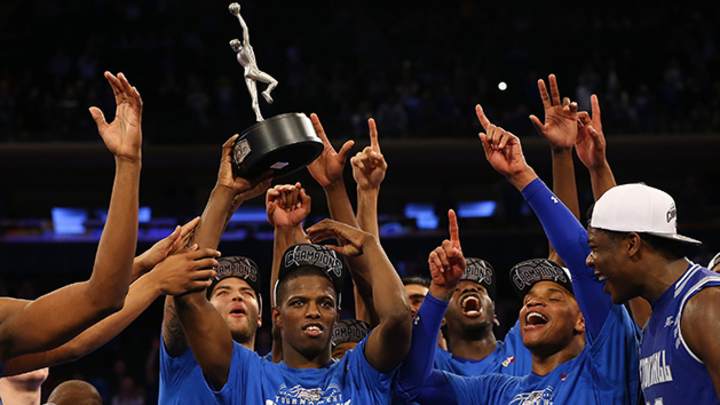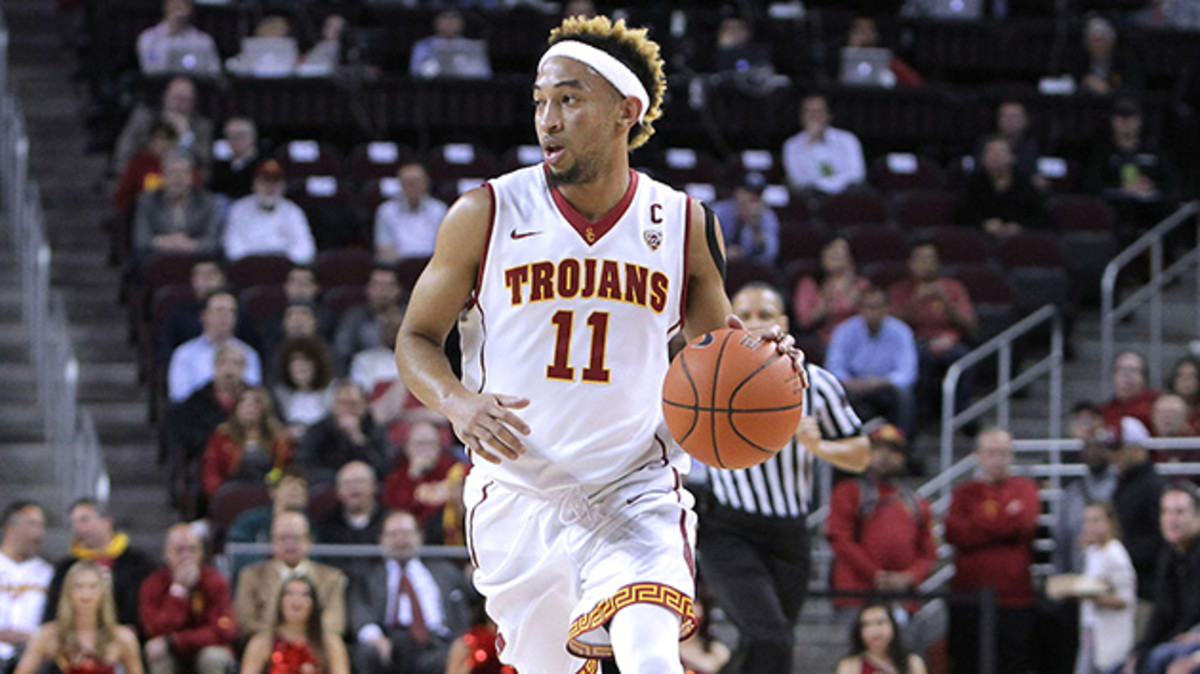Ten most surprising teams this season

Get all of Chris Johnson’s columns as soon as they’re published. Download the new Sports Illustrated app (iOS orAndroid) and personalize your experience by following your favorite teams and SI writers.
Every college basketball season features dozens of teams who exceed expectations. Their performance is considered “surprisingly” good. This is a subjective concept that is bound to create controversy, but SI.com attempted to highlight 10 squads who fit the bill. They are listed in alphabetical order.
Iowa (22–11, 12–6 Big Ten)
The Hawkeyes began a nasty downturn in late February, losing six of their final eight games entering the NCAA tournament, but that doesn’t erase what they accomplished earlier in the season. Iowa went 4–0 against No. 2 seed Michigan State and No. 5 seed Purdue, raced out to a 10–1 record in Big Ten play and climbed as high as No. 3 in the AP Top 25 poll. Ultimately Hawkeyes fans will likely remember this season more for what could have been than what actually took place, but don’t lose sight of everything they did before things went south.
• MORE: The 10 most disappointing teams of the season
Oregon (31–7, 14–4 Pac-12)
It’s not as if Oregon was expected to be a bad team this season; the Ducks were picked fourth in the preseason Pac-12 poll. However, they easily eclipsed that projection by winning 31 games, sweeping the Pac-12 regular season and conference tournament titles and earning a No. 1 seed in the NCAAs. The Ducks wielded one of the Pac-12’s top offenses, got major instant returns on a pair of newcomers—freshman guard Tyler Dorsey and junior college transfer Chris Boucher—and saw sophomore wing Dillon Brooks improve his scoring efficiency while handling a larger possession load. Unfortunately for Oregon, it ran into Buddy Hield and the Oklahoma Sooners in the Elite Eight.
Saint Mary’s (29–6, 15–3 WCC)
The Gaels lost five of their top six scorers from last season, including All-West Coast Conference first-team members Kerry Carter and Brad Waldow. Yet they finished this season 32 spots higher in kenpom.com’s team rankings and with eight more wins. Sophomore guard Emmett Naar, a native of Sydney, Australia, and junior guard Joe Rahon, a transfer from Boston College, were the playmaking engines for an offense that finished 22nd nationally in adjusted points per possession. And junior forward Dane Pineau, another native of Australia (Melbourne), was an effective finisher from close range and rated out as one of the best rebounders in the WCC.

Seton Hall (25–9, 12–6)
Kevin Willard could be found on a number of hot seat lists entering last season. He has since been named the Big East Co-Coach of the Year—along with Villanova’s Jay Wright—and led the Pirates to the program’s first conference tournament title since 1993. Don’t let Seton Hall’s blowout loss in the first round of the NCAA tournament to No. 11 seed Gonzaga fool you: This was an excellent team from the end of January on. The Pirates won 12 of their final 14 games heading into the NCAAs, including two victories over No. 2 seed Xavier, and they were the last squad to beat the national champion Wildcats.
Syracuse (23–14, 9–9 ACC)
Duke, Villanova lead Way Too Early top 25 for 2016–17 season
The Orange weren’t viewed as a lock to make the tourney entering Selection Sunday. But they rattled off a series of impressive wins, including over No. 1 seed Virginia, to reach the Final Four. The Orange had limited depth (second-to-last nationally in bench minutes) but the players they did have were very good. Senior point guard Michael Gbinije was one of the ACC’s top playmakers (27.0 assist rate in conference play), freshman wing Malachi Richardson made 41.5% of his three-point attempts during ACC play and keyed Syracuse’s second-half comeback against the Cavaliers and fellow freshman Tyler Lydon made an impact as a shot-blocker and perimeter shooter.
Texas A&M (28–9, 13–5 SEC)
The Aggies merit inclusion on this list for one 44-second stretch of basketball, when they erased a 12-point deficit to force overtime against (and eventually beat) Northern Iowa in the second round of the NCAAs. But they did more than that. Texas A&M reached 28 wins and clinched a No. 3 tourney seed, first and foremost, because of its defense. During SEC play the Aggies turned opponents over on 20.7% of their possessions, the highest mark in the conference—with senior guard Alex Caruso recording an SEC-high 3.8 steal percentage—and led the conference in adjusted efficiency. Texas A&M also got important contributions from its freshman class, including shooting guard Admon Gilder and center Tyler Davis.
Texas Tech (19–13, 9–9 Big 12)
The Red Raiders didn’t win a game in the NCAAs or even finish in the top half of the Big 12. But they did perform better than most observers thought they would—including SI.com, which pegged them as the 105th-best team in the nation before the season. Texas Tech reeled off a five-game winning streak in the middle of February that included victories over Iowa State, Baylor and Oklahoma and finished with a .500 record in the nation’s toughest league. Coach Tubby Smith’s team excelled at drawing fouls and capitalized on its opportunities at the free-throw line by converting 76.1% of its attempts during Big 12 play, the best mark in the conference.

USC (21–13, 9–9 Pac-12)
The Trojans’ season ended in brutal fashion—on a game-winning layup from Providence’s Rodney Bullock with 1.5 seconds remaining in the first round of the NCAA tournament—but coach Andy Enfield’s team was far from a sure bet even to go dancing before the season. SI.com projected the Trojans to finish 10th in the Pac-12. But USC wound up emerging from a group of just-O.K. teams in the conference to win its most games in a season (21) since 2009 and clinch its first tourney berth since 2011. And yet, the Trojans should be even better next season, as they ranked 303rd nationally in experience in 2015–16.
West Virginia (26–9, 13–5 Big 12)
While the college basketball world was going crazy over Hield’s ridiculous offensive output and marveling at Kansas’s insane conference title streak, another Big 12 team won 26 games and earned a No. 3 seed in the tourney. The Mountaineers suffocated opponents with a press defense that forced turnovers on a fourth of their possessions—the second-highest mark in the country, behind only Stephen F. Austin, which they lost to in the NCAAs—and they grabbed a nation-high 42.0% of their missed shots, with junior Devin Williams emerging as one of the top glass-cleaners in the country. West Virginia wasn’t just good; it posed a massive stylistic challenge.
• MORE: The 10 most surprising players of the season
Xavier (28–6, 14–4)
There was good cause to doubt the Musketeers entering this season after they waved farewell to their top scorer (Matt Stainbrook), rebounder (Stainbrook) and assister (Dee Davis). Yet coach Chris Mack led his team to 28 wins and a No. 2 seed in the tourney, the highest in program history. Redshirt freshman Edmond Sumner shone at point guard, wing Trevon Bluiett improved in his sophomore season, senior James Farr and junior Jalen Reynolds ranked as two of the Big East’s top rebounders and Xavier posted top-20 efficiency marks on both ends of the court. In the end, it took a fadeaway, buzzer-beating three from Wisconsin’s Bronson Koenig to end the Musketeers’ season.
Statistical support from sports-reference.com and kenpom.com.
